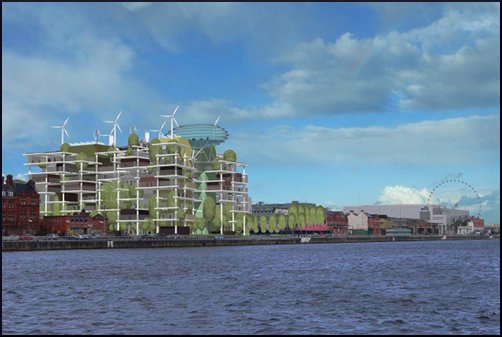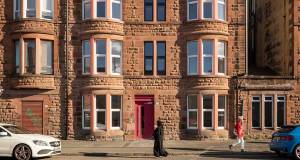- Blogs
- Posted
Central Bank pay double for Anglo site, green regenerative proposal shunned

The Central Bank's reported €8m bid for the site on which the defunct Anglo Irish Bank's ghost HQ sits may be double the market value, it has been claimed.
Architect Paschal Mahoney – who is heading up the innovative Trees on the Quays proposal to create a landmark vertical park from the iconic concrete shell for the Anglo HQ – had an independent valuation of the site done as part of a proposal to turn the defunct structure into a symbol and catalyst of Ireland's regeneration.
"I've heard from several sources that people have valued it and the price the Central Bank are offering may be about twice the actual value," Mahoney told Construct Ireland. "We've had it independently valued too. The price being offered is almost twice what the valuers have told us its worth. The taxpayer would be paying €8m for something we already own."
A not-for-profit company, Trees on the Quays (TOTQ) is a voluntary initiative by a consortium of companies with considerable experience in the design, planning and implementation of large high-profile projects.
Mahoney explained that TOTQ is seeking to acquire the site and to use it – and the shell of the existing structure – to create a globally recognizable landmark for Dublin, capable of bringing significant economic and social value to the city.
“Our position is that while the Central Bank can re-locate to any one of many locations in Dublin,” he said, “this site provides a unique opportunity to create an iconic structure for Dublin – something we are sadly lacking – and that use of the site as yet another commercial office would represent an incalculable loss to Dublin, and indeed to the country.
“We propose to create a beautiful, innovative vertical park confidently and proudly located on the Liffey Quays – a landmark visible not only within the city but also on the broader world stage.” Mahoney said the park would create a globally recognizable showcase and a branding standard for environmentally responsible urban projects, attracting a broad range of industries and businesses to associate with the initiative and to locate in the city.
“The people of Ireland can take possession of this, and create a public space in an area where there's no real quality urban space,” he said. “It's the first opportunity since the Georgian era to create a substantial new urban space in the central core of the city – a space that's extremely innovative and focused on a new perception, a new future, a new Ireland. This would also coincide with the centenary of the Irish republic in 2016. What are we going to have as our centenary project? A new central bank?”
For many people, there may be a bitter irony in the notion of the Central Bank moving into a building that had become an icon for Ireland’s speculative property bubble – suggesting a continuity in the banking sector’s splurge on property which played such a key role in Ireland’s economic woes, with a regulator that failed to control a flahulach banking sector seeking to buy a building that smacks of self-aggrandisement. Mahoney argues that the TOTQ proposal would instead seek to convert a structure that has become a totem for Ireland’s past excesses into a symbol of Ireland’s creative response to such adversity.
“It's such a visible construction, and [the Trees on the Quays proposal] would portray a confident outlook – showing the ability of the Irish people to be creative and turn a negative situation into a positive,” he said. “On the turn of our centenary we would be looking to a new and brighter future that is more sustainable – a legacy for future generations.
“We have an absolutely unique opportunity in time and in place. Extraordinary circumstances have left that shell. Rather than just ignoring it we have an opportunity to grasp the nettle and produce something like the High Line in New York City showing creativity, innovation, confidence and maturity.”
A linear park built on a 1.45-mile section of the former elevated train track in New York, The High Line is an aerial park which spurred real estate development in the neighborhoods which lie along the line. According to Mahoney, the Anglo site offers similar potential for Ireland. “We believe there's an absolutely sound business case here,” he said. “The High Line cost New York an estimated €150m, but it has already generated an estimated €4 bn in terms of how it increased the value of perimeter properties and how it brought benefits in terms of tourism and attracting investment.”
According to Mahoney, TOTQ isn't even looking for public finance. “It would be self-sustaining,” he said. “The funding of the project will come primarily through donors. We're already in discussion with various philanthropic bodies who are interested in the project and were confident that we would have significant high net worth individuals.” TOTQ would also draw in crowd funding, by giving people with a connection to Ireland the chance to pay to have their family history etched into the concrete structure and into an associated digital memory bank. “We will etch the story of the donors – the history of when their family either left or moved to Ireland, such as the Murphy family who left Ireland in 1887 and live in Boston Massachusetts in 2012. This could be in the region of 200,000 family journeys of people leaving and coming into Ireland. That's a funding stream that will work over time. It becomes an opportunity for genealogy tourism.
“We have a vision for a greener Ireland, an inclusive Ireland where we're creating a civic space, an innovative Ireland showcasing green technologies, and a global Ireland - a global image for the country using the benefit of Ireland's broad diaspora.”

The Trees on the Quays project has five strategic objectives:
- create a symbol of renewal to increase the global perception that Ireland is sustainable, inclusive and innovative;
- increase tourism by creating a unique attraction;
- attract foreign direct investment and impact on Brand Ireland by creating a centre of excellence on new media and green technology;
- attract global talent by making Dublin a more attractive place to be, identifying Dublin as a creative society;
- increase amenity of the North Lotts area for residents and businesses.
The companies involved in Trees on the Quays include Arup, Bruce Shaw, Accenture, Kilroys Solictors, Mahoney Architecture, EcoCo, TPA, Weir Conway, Cybercom, Areaman Productions, TSA Consulting, Lotts Architecture & Urbanism & Design Factory. “We have several prominent project supporters across the philanthropic, political, business and media spectrums,” said Mahoney. “We’re being advised and supported by Accenture in regard to our overall development plans.
“We’re now stepping up our campaign,” said Mahoney. “We’re in the process of finalising our expression of interest, and intend to complete this in the near future. We’re looking for further public support.”
To find out how to show your support for Trees on the Quays visit www.treesonthequays.com or visit the organisation’s Facebook page.







